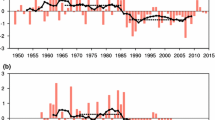Abstract
A decadal change of the tropical tropospheric temperature (TT) was identified to occur in the winter of 1997. Compared with that in the former period (1979–1996), the wintertime TT was significantly high over most of the tropical regions except over the tropical eastern Pacific during the latter period (1997–2014) because the sea surface temperature (SST) exhibited a decadal La Niña-like pattern after 1997. The warm SST anomalies over the tropical western Pacific facilitated enhanced precipitation and increased heat release to the tropical atmosphere, leading to a warmer tropical troposphere in the latter period. In addition to the mean TT values, the interannual variability of the tropical TT changed in 1997. The leading mode of the tropical TT explained 72.9 % of the total variance in the former period. It led to significant warming over midlatitude North America via a Pacific-North America (PNA)-like wave train and off the coast of East Asia via an anomalous lower-tropospheric anticyclone around the Philippines. The mode remained a similar pattern but explained 85.4 % of the total variance in the latter period, and its location was slightly westward-shifted compared with that in the former period. As a result, the structure of the PNA-like wave train changed, leading to anomalous warming over northwestern North America and enhanced precipitation over the southern North America. Meanwhile, the anomalous lower-tropospheric anticyclone around the Philippines shifted westward, leading to increased precipitation and regional warming over East Asia. The decadal changes of the leading mode of the tropical TT and its influences on the extratropical climate can be attributed to the changes of the tropical SST variability.
摘要
热带对流层温度(TT)可以反映热带大气受到的非绝热加热。本研究表明,北半球冬季热带TT在1997年发生了年代际突变:一方面,受年代际La Niña型海温和降水的影响,热带TT的平均值在1997年后有显著增加,这表明热带大气受到的非绝热加热有年代际增强;另一方面,热带TT年际变率主模态的空间型和解释方差在1997年后有显著变化,从而导致在年际变化尺度上由热带TT引起的气温、降水异常在东亚和北美地区有显著改变。






Similar content being viewed by others
References
Chiang JCH, Sobel AH (2002) Tropical tropospheric temperature variations caused by ENSO and their influence on the remote tropical climate. J Clim 15:2616–2631
Xie SP, Hu K, Hafner J et al (2009) Indian Ocean capacitor effect on Indo-Western Pacific climate during the summer following El Niño. J Clim 22:730–747
Yulaeva E, Wallace JM (1994) The signature of ENSO in global temperature and precipitation fields derived from the microwave sounding unit. J Clim 7:1719–1736
Sobel AH, Bretherton CS (2000) Modeling tropical precipitation in a single column. J Clim 13:4378–4392
Horel JD, Wallace JM (1981) Planetary-scale atmospheric phenomena associated with the Southern Oscillation. Mon Weather Rev 109:813–829
Zhang R, Sumi A, Kimoto M (1996) Impact of El Niño on the East Asian monsoon: a diagnostic study of the’86/87 and’91/92 events. J Meteorol Soc Jpn 74:49–62
Wang B, Wu R, Fu X (2000) Pacific-East Asian teleconnection: how does ENSO affect East Asian climate? J Clim 13:1517–1536
Pan YH, Oort AH (1983) Global climate variations connected with sea surface temperature anomalies in the eastern equatorial Pacific Ocean for the 1958–73 period. Mon Weather Rev 111:1244–1258
Soden BJ (2000) The sensitivity of the tropical hydrological cycle to ENSO. J Clim 13:538–549
Gollan G, Greatbatch RJ, Jung T (2012) Tropical impact on the East Asian winter monsoon. Geophys Res Lett 39:L17801
Kosaka Y, Xie SP (2013) Recent global-warming hiatus tied to equatorial Pacific surface cooling. Nature 501:403–407
England MH, McGregor S, Spence P et al (2014) Recent intensification of wind-driven circulation in the Pacific and the ongoing warming hiatus. Nat Clim Change 4:222–227
Dee DP, Uppala SM, Simmons AJ et al (2011) The ERA-interim reanalysis: configuration and performance of the data assimilation system. Q J R Meteorol Soc 137:553–597
Xie P, Arkin PA (1997) Global precipitation: a 17-year monthly analysis based on Gauge observations, satellite estimates, and numerical model outputs. Bull Am Meteorol Soc 78:2539–2558
Rayner NA, Parker DE, Horton EB et al (2003) Global analyses of sea surface temperature, sea ice, and night marine air temperature since the late nineteenth century. J Geophys Res 108:4407
Holton JR (2004) An introduction to dynamic meteorology, 4th edn. Elsevier Academic Press, Burlington, pp 1–27
Trenberth KE, Solomon A (1994) The global heat balance: heat transports in the atmosphere and ocean. Clim Dyn 10:107–134
Chen S, Chen W, Yu B (2014) Asymmetric influence of boreal spring Arctic Oscillation on subsequent ENSO. J Geophys Res 119:11135–11150
Spencer RW, Christy JR (1992) Precission and radiosonde validation of satellite gridpoint temperature anomalies. Part I: MSU Channel 2. J Clim 5:847–857
Fu C, Wang Q (1992) The definition and detection of the abrupt climatic change. Sci Atmos Sin 16:482–493
Wang L, Chen W, Huang R (2007) Changes in the variability of North Pacific Oscillation around 1975/1976 and its relationship with East Asian winter climate. J Geophys Res 112:D11110
North GR, Bell TL, Cahalan RF et al (1982) Sampling errors in the estimation of empirical orthogonal functions. Mon Weather Rev 110:699–706
Chen W, Graf HF, Huang R (2000) The interannual variability of East Asian winter monsoon and its relation to the summer monsoon. Adv Atmos Sci 17:48–60
Wang L, Chen W, Zhou W et al (2009) Interannual variations of East Asian trough axis at 500 hPa and its association with the East Asian winter monsoon pathway. J Clim 22:600–614
Gong H, Wang L, Chen W et al (2015) Diverse influences of ENSO on the East Asian–Western Pacific winter climate tied to different ENSO properties in CMIP5 models. J Clim 28:2187–2202
Wang L, Chen W (2010) How well do existing indices measure the strength of the East Asian winter monsoon? Adv Atmos Sci 27:855–870
Acknowledgments
We thank the two anonymous reviewers for their insightful comments. This work was supported by the National Natural Science Foundation of China (41422501, 41230527) and the National Key Scientific Research Plan of China (2014CB953904).
Author information
Authors and Affiliations
Corresponding author
Ethics declarations
Conflict of interest
The authors declare that they have no conflict of interest.
About this article
Cite this article
Zhang, JY., Wang, L., Yang, S. et al. Decadal changes of the wintertime tropical tropospheric temperature and their influences on the extratropical climate. Sci. Bull. 61, 737–744 (2016). https://doi.org/10.1007/s11434-016-1054-6
Received:
Revised:
Accepted:
Published:
Issue Date:
DOI: https://doi.org/10.1007/s11434-016-1054-6




